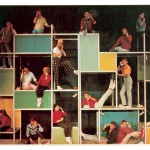The past few days, Guardian theater bloggers have been buzzing once again about how (or if) theater can coexist with new media. On one side of the debate, Lyn Gardner believes you should “Switch on Your Phones,” warning theaters that don’t “embrace the interactive age.” On the other side, Matt Trueman wonders if by keeping our “Noises Off,” there isn’t a better way “to bring theater to an Internet audience.”
For example, Gardner was happy to see a family not just watching a live show but also “engaging it” – texting, tweeting, posting, camming – using those digital “extra layers and interactions and points of entry.” She writes, “Even if they are there in person, audiences don’t just want to consume passively, they want to interact with others also present, and to curate and document their own experience and give it shape and narrative.”
While Gardner talks about passiveness, Trueman talks about liveness. He writes, “Theater exists in two forms online. There’s theater as digital content – live broadcasts, online video and so on – and there’s digital content related to theater, like marketing or education tools.” The first form engages audiences collectively in shared time, the second individually in their own time. The first is more live than the second, but both do engage the audience, even if not as actively as Gardner wants.
And what she wants is digital content not only online but also, in effect, onstage – which may be a dangerous tipping point. As Jared Lanier wrote in his 2010 book, You Are Not a Gadget, “Giving yourself time and place to think and feel is crucial to your existence,” crucial to avoiding a “culture of reaction.” Lanier believes, “You have to be somebody before you can share yourself.” How can you shape a narrative, as Gardner hopes, if you don’t take the time to step back and review it? More to the point, how can you be meaningfully engaged, if you are never fully attentive?
Even though theater as digital content and digital content related to theater continue to proliferate, Gardner believes companies are still not “responsive to the desire of audiences to not just consume but to be engaged, to be heard and to be creative too. If theater can use the tools available to collaborate with audiences on that, then its future is assured.” I’m not so sure.
The rise of storefront nickelodeons a century ago drew audiences away from vaudeville, but it was economics not the new media that forced vaudeville houses to close. It became impossible to earn enough during the Depression to meet the weekly nut of salaries and maintenance. So, the current recession worries me more than the current technology does. When its palaces shuttered, vaudeville moved to post-war nightclub cabarets, then to mid-century TV variety shows, and now to Las Vegas extravaganzas. While the venues have changed, vaudeville has continued.
Just as film put pressure on vaudeville, it also put pressure on “legit” theater. In response, the Little Theater Movement blossomed, from the Pasadena Playhouse to the Provincetown Players. A generation later, La Mama and Caffe Cino
gave rise to Off-Off-Broadway
in basement boutiques and coffeehouses. Theater will continue, probably not in the cash-hungry McPACs designed to promote “cultural tourism” but in the Main Street storefronts decimated by Big Box stores. Theater will only die if it tries to be something it isn’t, if it disembodies itself, if it aims to become iStage.

